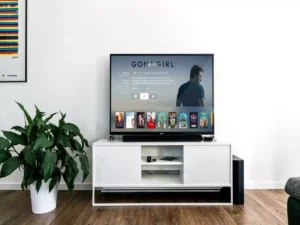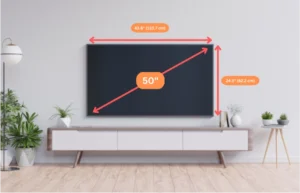Are you considering purchasing a new TV and wondering about the size of a 50 inch TV? If so, you have come to the right place. In this article, we will discuss how big is a 50 inch TV and provide some context to help you determine if this size is suitable for your needs.
In terms of actual dimensions, the size of a 50-inch TV can vary slightly depending on the aspect ratio (the ratio of the width to the height of the screen). However, for a standard 16:9 aspect ratio, which is common for most modern TVs, the approximate dimensions of a 50-inch TV would be around 43.6 inches (110.7 cm) in width and 24.5 inches (62.2 cm) in height.
It’s important to note that these dimensions are just estimates, and the specific measurements may vary slightly depending on the manufacturer and the design of the TV model.
TV sizes and dimensions

TV sizes are typically measured diagonally from one corner of the screen to the opposite corner. The size is usually given in inches, such as 32 inches, 40 inches, or 55 inches. The diagonal measurement is the most common way to measure the size of a TV, but it doesn’t necessarily give you a good sense of the actual dimensions of the TV.
To get a better sense of the TV’s dimensions, it’s helpful to know the aspect ratio. The aspect ratio is the ratio of the width to the height of the screen. The most common aspect ratio for TVs is 16:9, which means that the screen is 16 units wide for every 9 units of height. This is the same aspect ratio used for most movies and TV shows.
So, for example, if you have a 55-inch TV with a 16:9 aspect ratio, the screen will be approximately 48 inches wide and 27 inches tall. However, the overall dimensions of the TV will be larger than just the screen size, because there is also a frame or bezel around the screen.
The overall dimensions of a TV can vary quite a bit depending on the manufacturer and the design of the TV. For example, some TVs have very thin bezels, which means that the overall size of the TV will be closer to the size of the screen itself. Other TVs have thicker bezels, which can make the overall size of the TV quite a bit larger.
It’s also important to consider the depth of the TV. Flat-screen TVs are generally quite thin, but they still have some depth to them. This is particularly important if you plan to mount the TV on a wall, as you’ll need to make sure that the mount can support the weight of the TV and that there is enough clearance for the TV to fit properly.
What does “50 inch TV” mean?
When someone refers to a “50 inch TV,” they are typically talking about the diagonal size of the screen. This means that if you were to measure from one corner of the TV screen to the opposite corner, the measurement would be approximately 50 inches.
It’s important to note that this measurement refers only to the size of the screen itself, and not the overall size of the TV. The overall size of a TV can vary depending on factors such as the thickness of the bezel (the frame around the screen) and the depth of the TV.
In addition to the diagonal size of the screen, it’s also important to consider the aspect ratio of the TV. Most modern TVs have an aspect ratio of 16:9, which means that the screen is 16 units wide for every 9 units of height. This is the same aspect ratio used for most movies and TV shows.
So if someone is referring to a “50 inch TV,” they are likely talking about a TV with a 16:9 aspect ratio and a screen size that measures approximately 50 inches diagonally. This information can be helpful in determining whether a particular TV is the right size for your space and viewing needs.
Measuring a 50 inch TV screen
To measure a 50 inch TV screen, you will need a measuring tape or ruler. Start by measuring diagonally from one corner of the screen to the opposite corner. This measurement will give you the diagonal size of the screen, which is usually the measurement used when describing the size of a TV.
In the case of a 50 inch TV, the diagonal measurement should be approximately 50 inches, although it’s important to note that this measurement is not exact and may vary slightly depending on the specific TV model.
It’s also important to consider the aspect ratio of the TV. Most modern TVs have an aspect ratio of 16:9, which means that the screen is 16 units wide for every 9 units of height. This can be helpful in determining the actual dimensions of the screen, which will be wider than the diagonal measurement alone would suggest.
Overall, when measuring a 50 inch TV screen, it’s important to focus on the diagonal measurement as well as the aspect ratio, in order to get a clear sense of the actual size and dimensions of the screen.
Understanding aspect ratio and resolution
Aspect ratio and resolution are two important concepts to understand when it comes to display technology. Here’s a brief explanation of each:
Aspect Ratio:
Aspect ratio refers to the proportional relationship between the width and height of a display. The most common aspect ratio for TVs and computer monitors is 16:9, which means that the display is 16 units wide for every 9 units of height.
This is the same aspect ratio used for most movies and TV shows. However, there are other aspect ratios as well, such as 4:3, which was more common in older TVs and computer monitors, and 21:9, which is sometimes used for ultra-wide displays.
Resolution:
Resolution refers to the number of pixels that make up a display. The more pixels a display has, the higher its resolution and the sharper and more detailed the image will appear. Resolution is typically expressed as the number of pixels in the width and height of the display, such as 1920 x 1080 for a Full HD display. The higher the resolution, the more pixels there are and the more detailed the image will be.
Resolution and aspect ratio are related, but they are not the same thing. A display can have the same aspect ratio but different resolutions, or it can have the same resolution but different aspect ratios. For example, a 1080p display (1920 x 1080 resolution) can be either 16:9 or 4:3, depending on its aspect ratio.
It’s also worth noting that the aspect ratio and resolution of a display can affect how content is displayed on the screen. For example, if you watch a movie with a wider aspect ratio than your TV or monitor, you may see black bars at the top and bottom of the screen to preserve the correct aspect ratio.
Similarly, if you try to display content at a resolution that is too high or too low for your display, the image may appear stretched or pixelated. Overall, understanding aspect ratio and resolution is important for choosing the right display for your needs, as well as for optimizing the display settings to get the best image quality.
The physical dimensions of a 50 inch TV

The physical dimensions of a 50 inch TV can vary depending on the specific model and manufacturer, but there are some general guidelines that can help give you an idea of what to expect.
Typically, a 50 inch TV will have a screen that measures approximately 44 inches wide and 25 inches tall, with a diagonal measurement of around 50 inches. However, it’s important to note that the overall size of the TV can be larger due to the size of the bezel (the frame around the screen) and the depth of the TV itself.
In addition to the screen size, the physical dimensions of a 50 inch TV will depend on the specific design of the TV. Some TVs are designed to be slim and lightweight, while others may have a bulkier design with built-in speakers or other features.
If you’re shopping for a 50 inch TV and want to get an idea of its physical dimensions, it’s a good idea to look up the specific model online and check the manufacturer’s specifications. This can give you a more accurate sense of how much space the TV will take up in your room and whether it will fit comfortably on your TV stand or wall mount.
How big is the screen area of a 50 inch TV?
The screen area of a 50 inch TV can be calculated using the diagonal measurement of the screen and the aspect ratio of the TV. Most modern TVs have an aspect ratio of 16:9, which means that the screen is 16 units wide for every 9 units of height.
Using this information, we can calculate the screen area of a 50 inch TV as follows:
First, we need to calculate the height and width of the screen:
- To find the height of the screen, we can use the Pythagorean theorem: h^2 = d^2 / (1 + (16/9)^2), where h is the height, d is the diagonal measurement (in this case, 50 inches), and 16:9 is the aspect ratio.
- Plugging in the numbers, we get h^2 = 50^2 / (1 + (16/9)^2), which simplifies to h^2 = 625.
- Taking the square root, we get h = 25.
- To find the width of the screen, we can use the aspect ratio: w = 16/9 * h.
- Plugging in the height we just calculated, we get w = 16/9 * 25, which simplifies to w = 44.44 (rounded to two decimal places).
Therefore, the screen area of a 50 inch TV with a 16:9 aspect ratio is approximately 1103.12 square inches (calculated by multiplying the width and height together: 44.44 x 25 = 1103.12).
Comparing a 50 inch TV to other TV sizes
Comparing a 50 inch TV to other TV sizes can help give you a sense of how it fits into the range of available options. Here’s a brief overview of how a 50 inch TV compares to other common TV sizes:
- 32 inch: A 32 inch TV is much smaller than a 50 inch TV, with a screen area of approximately 439.35 square inches. This size is good for smaller rooms or for use as a secondary TV.
- 40-43 inch: A 40 or 43 inch TV is still smaller than a 50 inch TV, but offers a larger screen area than a 32 inch TV. The screen area for a 43 inch TV is approximately 730.11 square inches.
- 55 inch: A 55 inch TV is slightly larger than a 50 inch TV, with a screen area of approximately 1209.6 square inches. This size is good for larger rooms or for a more immersive viewing experience.
- 65 inch: A 65 inch TV is significantly larger than a 50 inch TV, with a screen area of approximately 1815.5 square inches. This size is great for larger living rooms or home theaters.
- 75 inch or larger: TVs that are 75 inches or larger are considered to be “big screen” TVs and are great for large, open spaces or for a truly immersive viewing experience. These TVs can have a screen area of 2808 square inches or more.
Ultimately, the right TV size for you will depend on a variety of factors, including the size of your room, your viewing distance, and your personal preferences. A 50 inch TV is a good mid-range option that offers a decent screen size without being too overwhelming for smaller spaces.
Distance recommendations for viewing a 50 inch TV
The optimal viewing distance for a 50 inch TV will depend on a variety of factors, including the resolution of the TV, the content being viewed, and personal preference.
However, as a general guideline, here are some distance recommendations for viewing a 50 inch TV:
- 1080p resolution: If your 50 inch TV has a resolution of 1080p (1920 x 1080 pixels), the optimal viewing distance is approximately 6-10 feet away from the screen. This distance will provide a comfortable viewing experience without causing eye strain or distortion.
- 4K resolution: If your 50 inch TV has a resolution of 4K (3840 x 2160 pixels), the optimal viewing distance is approximately 4-6 feet away from the screen. At this distance, you will be able to fully appreciate the increased level of detail and clarity provided by the 4K resolution.
- Viewing angle: It’s also important to consider the viewing angle when determining the optimal viewing distance for a 50 inch TV. For example, if you are sitting off to the side of the TV, you may need to be closer to the screen to fully appreciate the image.
Ultimately, the best viewing distance will depend on your personal preferences and the specific circumstances of your viewing environment. If possible, experiment with different distances to find the one that feels most comfortable for you.
Choosing the right size TV for your room
Choosing the right size TV for your room is important to ensure an optimal viewing experience. The size of the TV should be proportional to the size of the room and the distance between the viewer and the screen.
Here are some general guidelines to help you choose the right size TV for your room:
- Measure the distance between your viewing position and the wall where you plan to place the TV. A good rule of thumb is to divide this distance by 1.5 to determine the maximum screen size. For example, if your viewing distance is 8 feet, then a 55-inch TV would be the maximum recommended size.
- Consider the size of your room. A larger TV may overwhelm a small room, while a smaller TV may not be visible in a larger room. As a general rule, a 32-inch TV is suitable for a small room, while a 55-inch TV is appropriate for a medium-sized room. For larger rooms, consider a 65-inch TV or larger.
- Think about the purpose of the TV. If you plan to use it primarily for gaming or watching movies, a larger screen size may be preferable. If you plan to use it for regular TV viewing, a smaller screen size may be sufficient.
- Don’t forget to take into account the viewing angle. If you have a wide seating area, consider a TV with a wider viewing angle to ensure everyone can see the screen.
Mounting options for a 50 inch TV

There are several mounting options available for a 50-inch TV, including:
- Wall mount: A wall mount is a popular choice for mounting a 50-inch TV. You can choose between a fixed wall mount or a tilting wall mount. A fixed wall mount will keep the TV flush against the wall, while a tilting wall mount allows you to adjust the angle of the TV up or down.
- Stand: A stand is another option for mounting a 50-inch TV. You can choose between a tabletop stand or a floor stand. A tabletop stand will sit on a piece of furniture, while a floor stand will stand on its own.
- Ceiling mount: A ceiling mount is a less common option for mounting a 50-inch TV, but it can be a good choice if you have limited wall space or want to mount the TV in a unique location.
- Corner mount: If you want to mount your TV in a corner, a corner mount is a good option. This type of mount is designed to fit into the corner of the room and hold the TV at an angle that allows you to see the screen from different parts of the room.
When choosing a mounting option for your 50-inch TV, consider the size and weight of your TV, the location where you want to mount it, and the viewing angle you want to achieve. You should also make sure that the mount you choose is compatible with your TV and that you follow the manufacturer’s instructions for installation.
Brands and models of 50 inch TVs
There are many brands and models of 50-inch TVs available on the market. Here are a few examples:
- Samsung TU8000: This is a popular 50-inch 4K TV from Samsung that features a crystal clear display, built-in voice assistants, and a sleek design.
- LG NanoCell 81 Series: This is a 50-inch 4K TV from LG that features advanced display technology for superior picture quality, as well as built-in smart features and voice control.
- Sony X800H: This is a 50-inch 4K TV from Sony that features advanced color and contrast technology, as well as built-in voice assistants and compatibility with popular streaming services.
- TCL 5-Series: This is a 50-inch 4K TV from TCL that offers a great balance of price and performance, with features like HDR support and built-in Roku streaming.
- Vizio M-Series Quantum: This is a 50-inch 4K TV from Vizio that features advanced Quantum Color technology for vivid and lifelike colors, as well as support for popular streaming services and voice assistants.
- Hisense H8G: This is a 50-inch 4K TV from Hisense that features advanced display technology and built-in smart features, including voice control and compatibility with popular streaming services.
When shopping for a 50-inch TV, it’s important to consider factors such as picture quality, smart features, and price, as well as the reputation and reliability of the brand.
Recommended:
- How big is 2mm?
- How big is 8 inches?
- How big is 100 square feet?
- 1000 yards to miles
- How many stories is 100 feet?
Conclusion
If you want to know how big is a 50 inch TV, then you are just in the right place. A 50-inch TV is a relatively large television that offers a great viewing experience for movies, sports, and other entertainment.
The size of a 50-inch TV can vary depending on the model and design, but generally speaking, it will be around 44 inches wide and 25 inches tall, making it a good fit for medium-sized rooms. When choosing a 50-inch TV, it’s important to consider factors such as picture quality, smart features, and mounting options to ensure that you get the best possible viewing experience.

